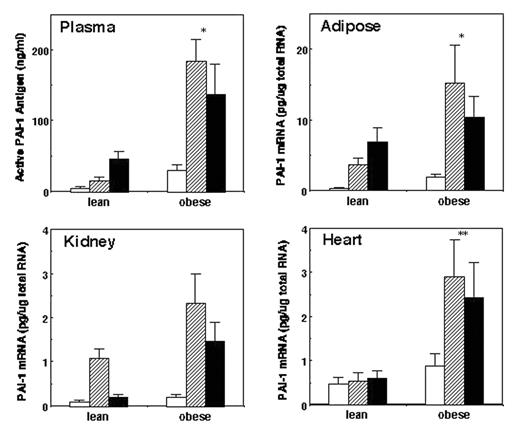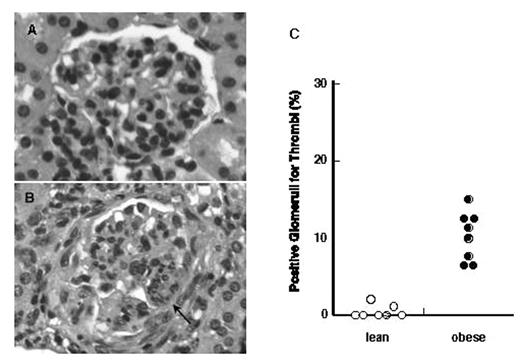Abstract
Cardiovascular/thrombotic diseases are frequently induced by a variety of stressors. Obese patients are susceptible to thrombotic diseases associated with stress, but the underlying mechanisms are unknown. We previously reported that restraint stress to mice caused a significant induction of a primary inhibitor of fibrinolysis, plasminogen activator inhibitor-1 (PAI-1), in association with tissue microthrombosis. We have investigated the effect of obesity on the stress-induced PAI-1 expression using genetically obese mice. Male obese mice (C57BL/6J ob/ob) of 6 weeks old and their lean counterparts (C57BL/6J +/?) were placed into 50-100 ml conical centrifuge tubes fitted with multiple punctures so as to allow ventilation. The tubes were placed in horizontal holders and the animals thus maintained for a continuous period of restraint. After 2 or 20 hours of restraint, the mice (n=8) were sacrificed, and the plasma and tissues were harvested. PAI-1 antigen in plasma was measured by ELISA and PAI-1 mRNA in tissues was quantitated by competitive RT-PCR assay. Obese mice were hyperresponsive to short- and long-duration of restraint stress in the induction of PAI-1 antigen in plasma and PAI-1 mRNA in tissues, especially in their hearts and adipose tissues (Fig. 1).
In situ hybridization analysis of the stressed mice revealed that strong signals for PAI-1 mRNA were localized to adipocytes, cardiovascular endothelial cells, and renal glomerular cells in obese animals. Immunohistochemical analysis for fibrin revealed that renal glomerular fibrin deposition was induced by 2 hour-restraint stress in obese mice (arrow in Fig. 2B), but rare in lean mice (Fig. 2A). Quantitative evaluation of fibrin was also achieved by counting the number of fibrin-positive glomeruli in each kidney section in a blinded fashion (Fig. 2C).
Elevation of tumor necrosis factor-alpha (TNF-alpha) level in plasma after stress was pronounced in obese mice and pre-treatment of mice with anti-TNF-alpha antibody partially attenuated the stress-mediated induction of PAI-1 gene in adipose tissues. These results suggest that larger induction of PAI-1 may be relevant to the increased risk of stress-induced thrombosis in obese subjects and that TNF-alpha may be involved. This study presents a novel finding regarding the molecular process of the stress-induced thrombosis in obesity, and suggests that PAI-1, stress, and obesity, may be closely associated with the increased risk for cardiovascular and thrombotic diseases.
Author notes
Corresponding author



